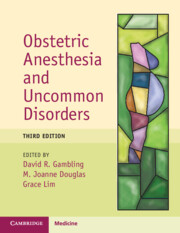Book contents
- Obstetric Anesthesia and Uncommon Disorders
- Obstetric Anesthesia and Uncommon Disorders
- Copyright page
- Cover Illustration
- Epigraph
- Contents
- Preface to Obstetric Anesthesia and Uncommon Disorders, 3rd edition
- Glossary of Common Abbreviations Used in this Text
- Gambling et al.: Obstetric Anesthesia: List of Contributors
- Chapter 1 Obstetric Anesthesia for the Parturient with Complex Medical Diseases
- Chapter 2 Point-of-Care Ultrasound for Obstetrics: Basics and Introductory Chapter
- Chapter 3 FoCUSed Cardiac Ultrasound for Cardiac Disorders
- Chapter 4 Challenging Cardiac Disorders in Pregnancy
- Chapter 5 Uncommon Cardiac Dysrhythmias in Pregnancy
- Chapter 6 Arterial Vascular Diseases
- Chapter 7 Uncommon Respiratory Disorders in Pregnancy
- Chapter 8 Airway Issues
- Chapter 9 Use of Neuraxial Ultrasound for Axial Skeletal Conditions
- Chapter 10 Myopathies and the Parturient
- Chapter 11 Parturients of Short Stature
- Chapter 12 Disorders of the Vertebral Column
- Chapter 13 Miscellaneous Skeletal and Connective Tissue Disorders
- Chapter 14 Disorders of the Central Nervous System in Pregnancy
- Chapter 15 Spinal Cord Disorders
- Chapter 16 Peripheral Neuropathies
- Chapter 17 Disorders of Intermediaries of Metabolism and Malignant Hyperthermia
- Chapter 18 Hepatic Conditions
- Chapter 19 Renal Diseases in Pregnancy
- Chapter 20 Rare Endocrine Disorders
- Chapter 21 Disorders of Blood, Coagulation, and Bone Marrow
- Chapter 22 Infectious Diseases in Pregnancy
- Chapter 23 Dermatologic Conditions in Pregnancy
- Chapter 24 Psychiatric Disorders in Pregnancy
- Chapter 25 Substance Use Disorder
- Chapter 26 Autoimmune Disease
- Chapter 27 Genetic Disorders
- Chapter 28 Anesthesia for Rare Fetal and Placental Conditions
- Index
- Plate Section (PDF Only)
- References
Chapter 13 - Miscellaneous Skeletal and Connective Tissue Disorders
Published online by Cambridge University Press: 26 January 2024
- Obstetric Anesthesia and Uncommon Disorders
- Obstetric Anesthesia and Uncommon Disorders
- Copyright page
- Cover Illustration
- Epigraph
- Contents
- Preface to Obstetric Anesthesia and Uncommon Disorders, 3rd edition
- Glossary of Common Abbreviations Used in this Text
- Gambling et al.: Obstetric Anesthesia: List of Contributors
- Chapter 1 Obstetric Anesthesia for the Parturient with Complex Medical Diseases
- Chapter 2 Point-of-Care Ultrasound for Obstetrics: Basics and Introductory Chapter
- Chapter 3 FoCUSed Cardiac Ultrasound for Cardiac Disorders
- Chapter 4 Challenging Cardiac Disorders in Pregnancy
- Chapter 5 Uncommon Cardiac Dysrhythmias in Pregnancy
- Chapter 6 Arterial Vascular Diseases
- Chapter 7 Uncommon Respiratory Disorders in Pregnancy
- Chapter 8 Airway Issues
- Chapter 9 Use of Neuraxial Ultrasound for Axial Skeletal Conditions
- Chapter 10 Myopathies and the Parturient
- Chapter 11 Parturients of Short Stature
- Chapter 12 Disorders of the Vertebral Column
- Chapter 13 Miscellaneous Skeletal and Connective Tissue Disorders
- Chapter 14 Disorders of the Central Nervous System in Pregnancy
- Chapter 15 Spinal Cord Disorders
- Chapter 16 Peripheral Neuropathies
- Chapter 17 Disorders of Intermediaries of Metabolism and Malignant Hyperthermia
- Chapter 18 Hepatic Conditions
- Chapter 19 Renal Diseases in Pregnancy
- Chapter 20 Rare Endocrine Disorders
- Chapter 21 Disorders of Blood, Coagulation, and Bone Marrow
- Chapter 22 Infectious Diseases in Pregnancy
- Chapter 23 Dermatologic Conditions in Pregnancy
- Chapter 24 Psychiatric Disorders in Pregnancy
- Chapter 25 Substance Use Disorder
- Chapter 26 Autoimmune Disease
- Chapter 27 Genetic Disorders
- Chapter 28 Anesthesia for Rare Fetal and Placental Conditions
- Index
- Plate Section (PDF Only)
- References
Summary
This chapter discusses a variety of miscellaneous conditions found during pregnancy, each with different degrees of rarity. It focuses on the pathophysiologic changes that occur with each disease in order to highlight the impact on both anesthetic and obstetric management. However, as some of the conditions described have a wide and varied organ involvement, firm management conclusions cannot be made. Each case should be assessed individually and may necessitate a multidisciplinary approach involving obstetricians, anesthesiologists, and neonatologists.
Keywords
- Type
- Chapter
- Information
- Obstetric Anesthesia and Uncommon Disorders , pp. 175 - 205Publisher: Cambridge University PressPrint publication year: 2024



